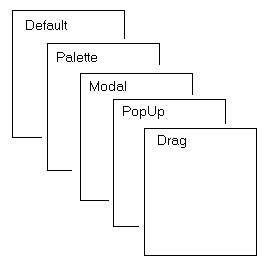JLayeredPane (Java Platform SE 8 ) (original) (raw)
JLayeredPane adds depth to a JFC/Swing container, allowing components to overlap each other when needed. An Integer object specifies each component's depth in the container, where higher-numbered components sit "on top" of other components. For task-oriented documentation and examples of using layered panes seeHow to Use a Layered Pane, a section in The Java Tutorial.

For convenience, JLayeredPane divides the depth-range into several different layers. Putting a component into one of those layers makes it easy to ensure that components overlap properly, without having to worry about specifying numbers for specific depths:
DEFAULT_LAYER
The standard layer, where most components go. This the bottommost layer.
PALETTE_LAYER
The palette layer sits over the default layer. Useful for floating toolbars and palettes, so they can be positioned above other components.
MODAL_LAYER
The layer used for modal dialogs. They will appear on top of any toolbars, palettes, or standard components in the container.
POPUP_LAYER
The popup layer displays above dialogs. That way, the popup windows associated with combo boxes, tooltips, and other help text will appear above the component, palette, or dialog that generated them.
DRAG_LAYER
When dragging a component, reassigning it to the drag layer ensures that it is positioned over every other component in the container. When finished dragging, it can be reassigned to its normal layer.
The JLayeredPane methods moveToFront(Component),moveToBack(Component) and setPosition can be used to reposition a component within its layer. The setLayer method can also be used to change the component's current layer.
Details
JLayeredPane manages its list of children likeContainer, but allows for the definition of a several layers within itself. Children in the same layer are managed exactly like the normal Container object, with the added feature that when children components overlap, children in higher layers display above the children in lower layers.
Each layer is a distinct integer number. The layer attribute can be set on a Component by passing an Integer object during the add call.
For example:
layeredPane.add(child, JLayeredPane.DEFAULT_LAYER);or layeredPane.add(child, new Integer(10));
The layer attribute can also be set on a Component by calling
layeredPaneParent.setLayer(child, 10) on the JLayeredPane that is the parent of component. The layer should be set before adding the child to the parent.
Higher number layers display above lower number layers. So, using numbers for the layers and letters for individual components, a representative list order would look like this:
5a, 5b, 5c, 2a, 2b, 2c, 1a where the leftmost components are closest to the top of the display.
A component can be moved to the top or bottom position within its layer by calling moveToFront or moveToBack.
The position of a component within a layer can also be specified directly. Valid positions range from 0 up to one less than the number of components in that layer. A value of -1 indicates the bottommost position. A value of 0 indicates the topmost position. Unlike layer numbers, higher position values are lower in the display.
Note: This sequence (defined by java.awt.Container) is the reverse of the layer numbering sequence. Usually though, you will use
moveToFront,moveToBack, andsetLayer.
Here are some examples using the method add(Component, layer, position): Calling add(5x, 5, -1) results in:
5a, 5b, 5c, 5x, 2a, 2b, 2c, 1a Calling add(5z, 5, 2) results in:
5a, 5b, 5z, 5c, 5x, 2a, 2b, 2c, 1a Calling add(3a, 3, 7) results in:
5a, 5b, 5z, 5c, 5x, 3a, 2a, 2b, 2c, 1a Using normal paint/event mechanics results in 1a appearing at the bottom and 5a being above all other components.
Note: that these layers are simply a logical construct and LayoutManagers will affect all child components of this container without regard for layer settings.
Warning: Swing is not thread safe. For more information see Swing's Threading Policy.
Warning: Serialized objects of this class will not be compatible with future Swing releases. The current serialization support is appropriate for short term storage or RMI between applications running the same version of Swing. As of 1.4, support for long term storage of all JavaBeans™ has been added to the java.beans package. Please see XMLEncoder.